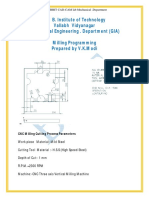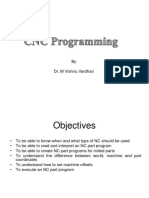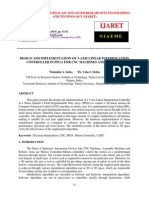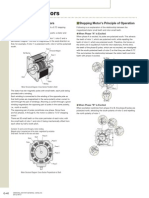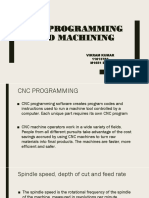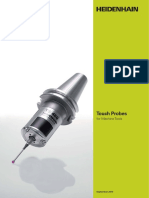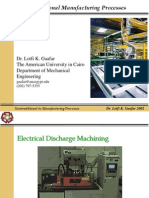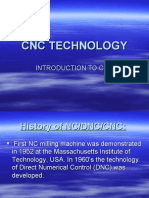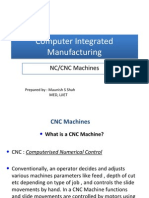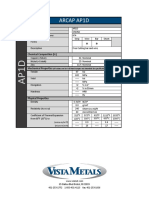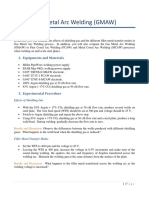Computer Numerical Control CNC: Ken Youssefi Mechanical Engineering Department
Computer Numerical Control CNC: Ken Youssefi Mechanical Engineering Department
Uploaded by
Sreedhar PugalendhiCopyright:
Available Formats
Computer Numerical Control CNC: Ken Youssefi Mechanical Engineering Department
Computer Numerical Control CNC: Ken Youssefi Mechanical Engineering Department
Uploaded by
Sreedhar PugalendhiOriginal Title
Copyright
Available Formats
Share this document
Did you find this document useful?
Is this content inappropriate?
Copyright:
Available Formats
Computer Numerical Control CNC: Ken Youssefi Mechanical Engineering Department
Computer Numerical Control CNC: Ken Youssefi Mechanical Engineering Department
Uploaded by
Sreedhar PugalendhiCopyright:
Available Formats
Ken Youssefi Mechanical Engineering Department
1
Computer Numerical Control
CNC
Ken Youssefi Mechanical Engineering Department
2
Numerical Control
Numerical control is a method of automatically
operating a manufacturing machine based on a
code of letters, numbers, and special characters.
The numerical data required to produce a part is
provided to a machine in the form of a program,
called part program or CNC program.
The program is translated into the appropriate
electrical signals for input to motors that run the
machine.
Ken Youssefi Mechanical Engineering Department
3
Numerical Control - History
The concept is credited to John Parson (1947). Using
punched cards he was able to control the position of a
machine in an attempt to machine helicopter blade.
US Air Force teamed up with MIT to develop a
programmable milling machine (1949).
In 1952, a three-axis Cincinnati Hydrotel milling machine
was demonstrated. The term Numerical Control (NC)
originated. The machine had an electromechanical
controller and used punched cards.
A new class of machines called machining centers and
turning centers that could perform multiple machining
processes was developed.
Modern NC machine has a computer on board, Computer
Numerical Control (CNC). They can run unattended at
over 20,000 rpm (spindler speed) with a feed rate of over
600 ipm and an accuracy of .0001
Ken Youssefi Mechanical Engineering Department
4
Computer Numerical Control (CNC)
A CNC machine is an NC machine with the added feature of
an on-board computer.
Ken Youssefi Mechanical Engineering Department
5
Hardware Configuration of NC Machine
Machine Control Unit (MCU)
the brain of the NC machine.
The Data Processing Unit (DPU)
reads the part program.
The Control Loop Unit (CLU)
controls the machine tool operation.
Ken Youssefi Mechanical Engineering Department
6
HAAS CNC Machines
Ken Youssefi Mechanical Engineering Department
7
CNC Machines
Machining Centers, equipped with automatic tool changers,
are capable of changing 90 or more tools. Can perform
milling, drilling, tapping, boring on many faces.
Ken Youssefi Mechanical Engineering Department
8
CNC Machines
Turning Centers are capable of executing many different types
of lathe cutting operations simultaneously on a rotating part.
Ken Youssefi Mechanical Engineering Department
9
CNC Controllers
The NC controller is the brain of the NC system, it controls all
functions of the machine.
Motion control deals with the tool position,
orientation and speed.
Auxiliary control deals with spindle rpm, tool
change, fixture clamping and coolant.
Many different types of controllers are available in the
market (GE, Fanuc, Allen-Bradley, Okuma, Bendix, ).
There are two basic types of control systems:
point-to-point and continuous path.
Ken Youssefi Mechanical Engineering Department
10
Point-to-Point Tool Movements
Point-to-point control systems cause the tool to move to a
point on the part and execute an operation at that point only.
The tool is not in continuous contact with the part while it is
moving.
Drilling, reaming, punching, boring and tapping are examples
of point-to-point operations.
Ken Youssefi Mechanical Engineering Department
11
Continuous-Path Tool Movements
Continuous-path controllers cause the tool to maintain
continuous contact with the part as the tool cuts a contour shape.
These operations include milling along any lines at any angle,
milling arcs and lathe turning.
Ken Youssefi Mechanical Engineering Department
12
Loop Systems for Controlling Tool Movement
Open Loop System
Uses stepping motor to create movement. Motors rotate a fixed
amount for each pulse received from the MCU. The motor sends a
signal back indicating that the movement is completed. No feedback
to check how close the actual machine movement comes to the exact
movement programmed.
Ken Youssefi Mechanical Engineering Department
13
Loop Systems for Controlling Tool Movement
Closed Loop System
AC, DC, and hydraulic servo-motors are used. The speed of these
motors are variable and controlled by the amount of current or fluid.
The motors are connect to the spindle and the table. A position sensor
continuously monitors the movement and sends back a single to
Comparator to make adjustments.
Ken Youssefi Mechanical Engineering Department
14
Flow of Computer-Aided
CNC Processing
Develop or obtain the 3D geometric model of the part,
using CAD.
Decide which machining operations and cutter-path
directions are required (computer assisted).
Choose the tooling required (computer assisted).
Run CAM software to generate the CNC part program.
Verify and edit program.
Download the part program to the appropriate machine.
Verify the program on the actual machine and edit if
necessary.
Run the program and produce the part.
Ken Youssefi Mechanical Engineering Department
15
Basic Concept of Part Programming
Part programming contains geometric data about the part
and motion information to move the cutting tool with
respect to the work piece.
Basically, the machine receives instructions as a sequence
of blocks containing commands to set machine parameters;
speed, feed and other relevant information.
A block is equivalent to a line of codes in a part program.
N135 G01 X1.0 Y1.0 Z0.125 T01 F5.0
Coordinates
Special function
Block number
G-code
Tool number
Ken Youssefi Mechanical Engineering Department
16
Basic Concept of Part Programming
Preparatory command (G code)
The G codes prepare the MCU for a given operation, typically
involving a cutter motion.
G00 rapid motion, point-to-point positioning
G01 linear interpolation (generating a sloped or straight cut)
G06 parabolic interpolation (produces a segment of a parabola)
G17 XY plane selection
G20 circular interpolation
G28 automatic return to reference point
G33 thread cutting
Ken Youssefi Mechanical Engineering Department
17
Basic Concept of Part Programming
Miscellaneous commands (M code)
M00 program stop
M03 start spindle rotation (cw)
M06 tool change
M07 turn coolant on
Feed commands (F code)
Used to specify the cutter feed rates in inch per minute.
Speed commands (S code)
Used to specify the spindle speed in rpm.
Tool commands (T code)
Specifies which tool to be used, machines with
automatic tool changer.
Ken Youssefi Mechanical Engineering Department
18
CNC Machine Axes of Motion
The coordinate system used for the tool path must be identical to the
coordinate system used by the CNC machine. The standards for machine
axes are established according to the industry standard report EIA RS-267A.
Right hand rule
Vertical
milling
machine
CNC machines milling machines can perform
simultaneous linear motion along the three
axis and are called three-axes machines.
Horizontal
milling
machine
Ken Youssefi Mechanical Engineering Department
19
CNC Machine Axes of Motion
Coordinate system for a Lathe
Ken Youssefi Mechanical Engineering Department
20
CNC Machine Axes of Motion
More complex CNC machines have the capability of executing
additional rotary motions (4
th
and 5
th
axes).
Ken Youssefi Mechanical Engineering Department
21
CNC Machine Axes of Motion
Five-axis
machine
configurations
Ken Youssefi Mechanical Engineering Department
22
CNC Machine Tool Positioning Modes
Within a given machine axes coordinate system, CNC can be
programmed to locate tool positions in the following modes;
incremental, absolute, or mixed.
Ken Youssefi Mechanical Engineering Department
23
Example of a part program
Loading tool
N003 G00 X0.0 Y0.0 Z40.0 T01 M06
Tool change
Rapid motion
Positioning tool at P
1
N004 G01 X75.0 Y0.0 Z-40.0 F350 M03 M08
Start spindle
Start coolant
Linear interpolation
N001 G91 (incremental)
N002 G71 (metric)
Ken Youssefi Mechanical Engineering Department
24
Example of a part program
Moving tool from P
1
to P
3
through P
2
N005 G01 X110
N006 G01 Y70.0
Tool dia.=10 mm
Moving tool from P
3
to P
4
along a straight line
and from P
4
to P
5
clockwise along circular arc.
N007 G01 X-40.86
N008 G02 X-28.28 Y0.0 I-14.14 J-5.0
Ken Youssefi Mechanical Engineering Department
25
Example of a part program
X and Y specify the end point of the arc (P5) with respect to the
start point (P4).
I and J specify the center of the arc with respect to the start point.
N008 G02 X-28.28 Y0.0 I-14.14 J-5.0
14.14
Ken Youssefi Mechanical Engineering Department
26
Computer-Assisted Part Programming
Identify the part geometry, cutter motions, speeds,
feeds, and cutter parameter.
Code the above information using ATP.
Compile to produce the list of cutter movements and
machine control information (Cutter Location data
file, CL).
Use post-processor to generate machine control data
for a particular machine. This is the same as NC
blocks.
Automatically Programmed Tools (ATP) language is the most
comprehensive and widely used program. The language is based
on common words and easy to use mathematical notations
Ken Youssefi Mechanical Engineering Department
27
Part Programming from CAD Database
Integrated CAD/CAM Systems
In an integrated CAD/CAM system, the geometry
and tool motions are derived automatically from
the CAD database by the NC program (Pro/E,
Unigraphics, .)
No need for manual programming or using APT
language.
Ken Youssefi Mechanical Engineering Department
28
I ntegrated CAD/CAM System
The CAD system is used to develop a geometric model of
the part which is then used by the CAM system to generate
part programs for CNC machine tools.
Both CAD and CAM functions may be performed either by
the same system or separate systems in different rooms or
even countries.
Extending the connection between CAD and CAM to its
logical limits within a company yields the concept of the
computer-integrated enterprise (CIE). In CIE all aspects of
the enterprise is computer aided, from management and
sales to product design and manufacturing.
CAD and Cam (Computer Aided Manufacturing) together
create a link between product design and manufacturing.
Ken Youssefi Mechanical Engineering Department
29
CAD/CAM
CAD/CAM systems allow for rapid development and
modifying of designs and documentation.
The 3D geometric model produced becomes a common
element for engineering analysis (FEA), machining
process planning (including CNC part programming,
documentation (including engineering drawings), quality
control, and so on.
The coupling of CAD and CAM considerably shortens
the time needed to bring a new product to market.
Increased productivity is generally the justification for
using CAD/CAM system.
Ken Youssefi Mechanical Engineering Department
30
Product Data Management System (PDM)
Product development cycle includes activities not only
in design and manufacturing but also in analysis,
quality assurance, packaging, shipping, and
marketing.
Software systems called product data management
(PDM) are available to smooth data flow among all
these activities.
Some available software; SDRCs Metaphase,
Unigraphicss IMAN, Computer Visions Optegra.
(web-enabled software).
Ken Youssefi Mechanical Engineering Department
31
Electrical Discharge Machine - EDM
Die-sinking EDM systems, the electrode (cutting tool) and workpiece are
held by the machine tool. The power supply controls the electrical
discharges and movement of the electrode in relation to the workpiece.
During operation the workpiece is submerged in a bath of dielectric fluid
(electrically nonconducting). (Die-Sinking EDM is also called Sinker,
Ram-Type, Conventional, Plunge or Vertical EDM)
Ken Youssefi Mechanical Engineering Department
32
EDM Die-Sinking (Plunge)
The spark discharges are pulsed on and off at a high frequency
cycle and can repeat 250,000 times per second. Each discharge
melts or vaporizes a small area of the workpiece surface.
During normal operation the electrode never touches the
workpiece, but is separated by a small spark gap.
The amount of material removed from the workpiece
with each pulse is directly proportional to the energy
it contains.
The electrode (plunger) can be a complex shape, and can be
moved in X, Y, and Z axes, as well as rotated, enabling more
complex shapes with accuracy better than one mil.
Plunge EDM is best used in tool
and die manufacturing, or creating
extremely accurate molds for
injection-molding plastic parts.
Ken Youssefi Mechanical Engineering Department
33
EDM
A relatively soft graphite or
metallic electrode can easily
machine hardened tool steels
or tungsten carbide. One of
the many attractive benefits
of using the EDM process.
The dielectric fluid performs the following functions:
It acts as an insulator until sufficiently high potential is
reached .
Acts as a coolant medium and reduces the extremely high
temp. in the arc gap.
More importantly, the dielectric fluid is pumped through
the arc gap to flush away the eroded particles between the
workpiece and the electrode which is critical to high metal
removal rates and good machining conditions.
Ken Youssefi Mechanical Engineering Department
34
EDM
The EDM process can be used on any material that is an
electrical conductor
The EDM process does not involve mechanical energy,
therefore, materials with high hardness and strength can
easily be machined.
Applications include producing die cavity for large
components, deep small holes, complicated internal
cavities
Dimensional accuracy of 0.0005 in is achievable.
Minimum wall thickness: .01 inch, over 5 inch span
Feature to feature positioning: .001
Ken Youssefi Mechanical Engineering Department
35
Wire EDM
Wire EDM machines utilize a very thin wire (.0008 to .012 in.)
as an electrode. The wire is stretched between diamond guides
and carbide that conduct current to the wire and cuts the part like
a band saw. Material is removed by the erosion caused by a spark
that moves horizontally with the wire.
Ken Youssefi Mechanical Engineering Department
36
Intricately detailed automobile part
EDM Examples
7075-T6 aluminum back plate latch, EDM
cost is less than half the milling cost.
These simple, flat shapes, used in food
processing, which usually would be stamped,
were wire EDMed instead because they required
a superior quality edge.
Ken Youssefi Mechanical Engineering Department
37
EDM Examples
To manufacture titanium
earring shapes wire EDM
proved the most cost
effective when compared
to stamping and laser
cutting.
Small gear (with insect
for scale) shows a
capability of EDM
micromachining.
Small parts made using EDM
Turbine blades
Ken Youssefi Mechanical Engineering Department
38
CNC Machines
Laser Machining and Cutting
The machine utilizes an intense beam of focused laser light to cut the part.
Material under the beam experiences a rapid rise in temp. and is vaporized.
Laser cuts with a minimum of distortion, no mechanical cutting forces. .
Gas is blown into the cut to clear away molten metals,
or other materials in the cutting zone. In some cases,
the gas jet can be chosen to react chemically with the
workpiece to produce heat and accelerate the cutting
speed
Ken Youssefi Mechanical Engineering Department
39
Today, laser cutting is used extensively for producing
profiled flat plate and sheet, for diverse applications in the
engineering industry sectors.
Metals, ceramics, polymers and natural materials such as
wood and rubber can all be cut using CO
2
lasers.
Sheet metal cutting has since become, by far, the
dominant industrial use of lasers in materials
processing. Approximately 12 000 industrial laser
cutting systems have been installed world-wide, with
a total market value of some 4.5 billion US dollars.
Over 60% of this equipment is installed in Japan.
Laser machining and Cutting
The first ever gas-assisted laser cuts were done in1967.
Ken Youssefi Mechanical Engineering Department
40
Laser machining and Cutting
Ken Youssefi Mechanical Engineering Department
41
Laser machining and Cutting
Excellent control of the laser beam with a stable motion
system achieves an extreme edge quality. Laser-cut parts
have a condition of nearly zero edge deformation, or roll-off
Laser cutting has higher accuracy rates over other
methods using heat generation, as well as water jet
cutting.
There is quicker turnaround for parts regardless of the
complexity, because changes of the design of parts can be
easily accommodated. Laser cutting also reduces wastage.
Advantages
It is also faster than conventional tool-making techniques.
Ken Youssefi Mechanical Engineering Department
42
Laser machining and Cutting
The material being cut gets very hot, so in narrow
areas, thermal expansion may be a problem.
Distortion can be caused by oxygen, which is sometimes
used as an assist gas, because it puts stress into the cut
edge of some materials; this is typically a problem in
dense patterns of holes.
Lasers also require high energy, making them costly to run.
Lasers are not very effective on metals such as
aluminum and copper alloys due to their ability to
reflect light as well as absorb and conduct heat. Neither
are lasers appropriate to use on crystal, glass and other
transparent materials.
Disadvantages
Ken Youssefi Mechanical Engineering Department
43
Laser machining and Cutting
Laser drilling hole Laser welding in automobile
industry
You might also like
- Foundry TechnologyDocument3 pagesFoundry TechnologyGunasegaran V50% (2)
- Fast BeamDocument2 pagesFast BeamSimila Razzak RahmanNo ratings yet
- Your Source For Ac & DC Motor ControlDocument128 pagesYour Source For Ac & DC Motor ControlJordan Moreira ValdezNo ratings yet
- NEW CNC Milling Program Compiled Byv K MODIDocument2 pagesNEW CNC Milling Program Compiled Byv K MODIVinit ModiNo ratings yet
- Design and Manufacturing of 8 Cylinder Hydraulic Fixture For Boring Yoke On VMC 1050Document8 pagesDesign and Manufacturing of 8 Cylinder Hydraulic Fixture For Boring Yoke On VMC 1050The ash Designe GalaryNo ratings yet
- By Group 7: Maintenance of CNC MachinesDocument27 pagesBy Group 7: Maintenance of CNC MachinesFerdian Gamalea DelastaNo ratings yet
- CNC Retrofit PackageDocument1 pageCNC Retrofit PackageJulie DillardNo ratings yet
- Mechanical Workshop Practice 20-21 (201 Copies)Document92 pagesMechanical Workshop Practice 20-21 (201 Copies)MOHAMMED MANSOORNo ratings yet
- Lecture Cad CamDocument84 pagesLecture Cad Camismail_69No ratings yet
- Report CNC f2036Document16 pagesReport CNC f2036Dasir Baluan AsiriNo ratings yet
- CIM LAB ManualDocument58 pagesCIM LAB ManualBruce ColonNo ratings yet
- Machine Tools - Lectures CNC Machines - 2018-2019 BatchDocument12 pagesMachine Tools - Lectures CNC Machines - 2018-2019 Batchshafikul37No ratings yet
- CNC Milling 2. CNC Turning 3. CNC Edm Wirecut 4. Cadcam 5. High Precision Grinding MachineDocument10 pagesCNC Milling 2. CNC Turning 3. CNC Edm Wirecut 4. Cadcam 5. High Precision Grinding MachineKubheran SelvathuraiNo ratings yet
- Fixtures For NCDocument13 pagesFixtures For NCMaha RajanNo ratings yet
- 11 Cad Cam CNC Programming MVVDocument37 pages11 Cad Cam CNC Programming MVVbassem smatiNo ratings yet
- CNC NotesDocument55 pagesCNC NotesFRANCIS THOMASNo ratings yet
- DFM LabDocument13 pagesDFM LabnannupnNo ratings yet
- Design and Implementation of 3 Axis Linear Interpolation Controller in Fpga For CNC Machines and RoboticsDocument11 pagesDesign and Implementation of 3 Axis Linear Interpolation Controller in Fpga For CNC Machines and RoboticsIAEME Publication100% (1)
- Industrial Automation Industrial Automation: Cad/Cam and CNCDocument24 pagesIndustrial Automation Industrial Automation: Cad/Cam and CNCGuillermo RamirezNo ratings yet
- Stepping Motors Brushless Pag 21Document49 pagesStepping Motors Brushless Pag 21Luis R. Cabrales JimenezNo ratings yet
- Computer Numeric Control: Utkarsh AgarwalDocument30 pagesComputer Numeric Control: Utkarsh AgarwalUtkarshNo ratings yet
- Lab 6 - Face Milling On CNC MachineDocument5 pagesLab 6 - Face Milling On CNC MachineHaris NaveedNo ratings yet
- Kinematics of Machinery ManualDocument29 pagesKinematics of Machinery ManualShubham NaikNo ratings yet
- Topic:: CNC Edm MachineDocument4 pagesTopic:: CNC Edm Machinepokloh100% (1)
- CAMDocument9 pagesCAMJay JoshiNo ratings yet
- Unit 23: Computer Aided Design and Manufacture (CAD/CAM) : Unit Code J/615/1497 Unit Level 4 Credit Value 15Document6 pagesUnit 23: Computer Aided Design and Manufacture (CAD/CAM) : Unit Code J/615/1497 Unit Level 4 Credit Value 15Pratik008No ratings yet
- Unit 4Document62 pagesUnit 4samnztNo ratings yet
- Study of The Effect of Cutting Parameters On Thread ProfileDocument66 pagesStudy of The Effect of Cutting Parameters On Thread Profilemasihuzzamana100% (1)
- MCQ Cad Cam Cae SmshaikhDocument10 pagesMCQ Cad Cam Cae SmshaikhSameer shaikh100% (2)
- Optimisation of Surface Roughness in The CNC Milling ProcessDocument11 pagesOptimisation of Surface Roughness in The CNC Milling ProcessSuzanaPetrovicNo ratings yet
- CNC Programming and MachiningDocument12 pagesCNC Programming and MachiningMayank KumarNo ratings yet
- CNC/CAM Lecture Notes: Chapter 3 InterpolatorDocument32 pagesCNC/CAM Lecture Notes: Chapter 3 InterpolatorSutran ErwiyantoroNo ratings yet
- Rajkumar CV CNCDocument6 pagesRajkumar CV CNCmrajkumarmandal123No ratings yet
- Computer Aided Manufacturing-IIDocument50 pagesComputer Aided Manufacturing-IIAbdul Hakeem Semar KamaluddinNo ratings yet
- CNC-Lab Mechanical ManualDocument21 pagesCNC-Lab Mechanical ManualHaresh RaisinghaniNo ratings yet
- FME CNC Unit 5Document78 pagesFME CNC Unit 5B30parvej arif shahNo ratings yet
- Module - 4Document71 pagesModule - 4Anand ANo ratings yet
- SET 2 - CNC Operator TurningDocument1 pageSET 2 - CNC Operator TurningtvaprasadNo ratings yet
- Probes HeidenhainDocument64 pagesProbes HeidenhainfbalestrinNo ratings yet
- Nontraditional Manufacturing ProcessesDocument157 pagesNontraditional Manufacturing ProcessesKiran AsknaniNo ratings yet
- CNC and Part ProgramDocument54 pagesCNC and Part ProgramAkatew Haile Mebrahtu100% (1)
- Automation Principles and StrategiesDocument25 pagesAutomation Principles and StrategiessrikanthNo ratings yet
- Engineering DrawingDocument8 pagesEngineering DrawingJit JagNo ratings yet
- CNC User Manual Version 67Document311 pagesCNC User Manual Version 67Adina Denisa DumitrescuNo ratings yet
- CNC SoftwareDocument11 pagesCNC SoftwareTegoeh SankenryokuNo ratings yet
- UNIT-3: Advances in MetrologyDocument42 pagesUNIT-3: Advances in MetrologyMebinNo ratings yet
- CNC Machines PDF NotesDocument7 pagesCNC Machines PDF Notesapi-228219106No ratings yet
- CNC TechnologyDocument40 pagesCNC TechnologymknttfNo ratings yet
- Quantitative Analysis of Flexible Manufacturing SystemDocument9 pagesQuantitative Analysis of Flexible Manufacturing SystemJaydeep PatelNo ratings yet
- Heidenhain Motors 938Document48 pagesHeidenhain Motors 938rccarlesNo ratings yet
- eNovaCNC Operating ManualDocument43 pageseNovaCNC Operating Manualswami061009No ratings yet
- Comparative Study of CNC Controllers Used in CNC Milling MachineDocument9 pagesComparative Study of CNC Controllers Used in CNC Milling MachineAJER JOURNALNo ratings yet
- Computer Aided Manufacturing SyllabusDocument1 pageComputer Aided Manufacturing SyllabusDeepak KumarNo ratings yet
- Hari Om Summer Training PPT CNCDocument44 pagesHari Om Summer Training PPT CNCAbhay TiwariNo ratings yet
- Materi 1. Dasar Mesin CNC, Jenis Mesin CNCDocument48 pagesMateri 1. Dasar Mesin CNC, Jenis Mesin CNCndyaudinaNo ratings yet
- CNC Machines ProgrammingDocument94 pagesCNC Machines Programmingejask2002No ratings yet
- An Introduction To Machine Tools and Computer Numerical Control (CNC)Document32 pagesAn Introduction To Machine Tools and Computer Numerical Control (CNC)Abey FrancisNo ratings yet
- CNC Basic & Prog.Document89 pagesCNC Basic & Prog.Christine BrownNo ratings yet
- CNC Part ProgrammingDocument53 pagesCNC Part ProgrammingmsshahenterNo ratings yet
- CNC Part ProgrammingDocument40 pagesCNC Part ProgrammingmsshahenterNo ratings yet
- NC & CNCDocument29 pagesNC & CNCtve21ie060No ratings yet
- 12 1 What Is A Force? 1 - ? F 1 M e S 2 S F: Ma? Define AcceDocument12 pages12 1 What Is A Force? 1 - ? F 1 M e S 2 S F: Ma? Define AcceSreedhar PugalendhiNo ratings yet
- OVA and OVFDocument3 pagesOVA and OVFSreedhar PugalendhiNo ratings yet
- 12 1 What Is A Force? 1 - ? F 1 M e S 2 S F: Ma? Define AcceDocument12 pages12 1 What Is A Force? 1 - ? F 1 M e S 2 S F: Ma? Define AcceSreedhar PugalendhiNo ratings yet
- Visi MouldDocument2 pagesVisi MouldSreedhar PugalendhiNo ratings yet
- DocumentDocument3 pagesDocumentSreedhar PugalendhiNo ratings yet
- 0000 EN DN TOF Timer Off Delay Timer Time Base Preset Accum TOFDocument1 page0000 EN DN TOF Timer Off Delay Timer Time Base Preset Accum TOFSreedhar PugalendhiNo ratings yet
- ) Appendh A-Typical Graphlc Symbols Lor Electrlcal Dlagrams WLTH Baslc Devlce Deslgnatlons SwrtchesDocument2 pages) Appendh A-Typical Graphlc Symbols Lor Electrlcal Dlagrams WLTH Baslc Devlce Deslgnatlons SwrtchesSreedhar PugalendhiNo ratings yet
- Lab 0 - Introduction To Laboratory: ObjectiveDocument2 pagesLab 0 - Introduction To Laboratory: ObjectiveSreedhar PugalendhiNo ratings yet
- Small Base Moldflow Analysis ReportDocument24 pagesSmall Base Moldflow Analysis ReportSreedhar PugalendhiNo ratings yet
- 42 PressesDocument3 pages42 PressesSreedhar PugalendhiNo ratings yet
- Implementation of 5S' Technique in A Manufacturing Organization: A Case StudyDocument13 pagesImplementation of 5S' Technique in A Manufacturing Organization: A Case StudySreedhar PugalendhiNo ratings yet
- Injection Molding Design GuidelinesDocument13 pagesInjection Molding Design GuidelinesSreedhar PugalendhiNo ratings yet
- D D P I M A C: Esign and Evelopment of Lastic Njection Oldfor UTO OmponentDocument7 pagesD D P I M A C: Esign and Evelopment of Lastic Njection Oldfor UTO OmponentSreedhar PugalendhiNo ratings yet
- DJF Module 3Document104 pagesDJF Module 3jestin100% (1)
- Park FabricatorsDocument50 pagesPark FabricatorsAnuj PanchalNo ratings yet
- ARCAP - Grades and PropertiesDocument7 pagesARCAP - Grades and PropertiesEminent RishNo ratings yet
- Ns ISO-4753-2011Document7 pagesNs ISO-4753-2011Patrik Alfredsson100% (1)
- 2021 Milling Strategy Guides EN2 WebDocument15 pages2021 Milling Strategy Guides EN2 Webnigay.labNo ratings yet
- Solid Carbide Spiral 'O' Flute, Aluminum Cutting CNC Router Bits - ToolsToday - Industrial Quality Router BitsDocument7 pagesSolid Carbide Spiral 'O' Flute, Aluminum Cutting CNC Router Bits - ToolsToday - Industrial Quality Router BitsHector InbacuanNo ratings yet
- Cell 1 - Op20 RlocDocument6 pagesCell 1 - Op20 RlocRaju NatarajanNo ratings yet
- WC67K CNC Hydraulic Sheet Metal Press Brake Bender Machine With DA41s SystemDocument7 pagesWC67K CNC Hydraulic Sheet Metal Press Brake Bender Machine With DA41s SystemryneleeNo ratings yet
- 2D511 Drilling ReamingDocument51 pages2D511 Drilling Reamingwienslaw5804100% (1)
- Forcec 2Document16 pagesForcec 2Leon BertossiNo ratings yet
- 508-GEN.00-CVL-002 - 0 - Lighting Pole FoundationDocument1 page508-GEN.00-CVL-002 - 0 - Lighting Pole Foundationrahman fatahNo ratings yet
- Mechanics of Metal Cutting-Cutting Tool: By: Dr. Pawan Sharma Assistant Professor SVNIT, SuratDocument25 pagesMechanics of Metal Cutting-Cutting Tool: By: Dr. Pawan Sharma Assistant Professor SVNIT, SuratShubham BorseNo ratings yet
- SmawDocument28 pagesSmawMallesh KaruparthyNo ratings yet
- European Steel and Alloy GradesDocument2 pagesEuropean Steel and Alloy Gradesfarshid KarpasandNo ratings yet
- Multus B300Document1 pageMultus B300cmganklNo ratings yet
- Design & Fabrication of Progressive Die For Making WasherDocument3 pagesDesign & Fabrication of Progressive Die For Making WasherJITENDRA SINGHNo ratings yet
- VIVA VOCE Questions FinalDocument5 pagesVIVA VOCE Questions FinalS.m. Chandrashekar100% (2)
- Lecture 1 - From OrpiDocument10 pagesLecture 1 - From OrpiNayeemur RahmanNo ratings yet
- Din 580 - 582 - Maximum Permissible Loads PDFDocument9 pagesDin 580 - 582 - Maximum Permissible Loads PDFAntohi CatalinNo ratings yet
- Setup Sheet Report: Mpmaster Generic 3/4-Axis VerticalDocument12 pagesSetup Sheet Report: Mpmaster Generic 3/4-Axis VerticalDaniel Peter LundNo ratings yet
- Montaza SarkiDocument78 pagesMontaza SarkiCaneNo ratings yet
- Summative Test Smaw 8Document3 pagesSummative Test Smaw 8Krizzie Jade Cailing100% (1)
- Gas Metal Arc Welding (GMAW) : Effects of Shielding GasDocument2 pagesGas Metal Arc Welding (GMAW) : Effects of Shielding GasxharpreetxNo ratings yet
- Outcome 9. Interchangeable ManufactureDocument43 pagesOutcome 9. Interchangeable ManufactureKishannNo ratings yet
- Is 617.1994Document19 pagesIs 617.1994bsunanda01No ratings yet
- BC-LP-001 2021-22Document2 pagesBC-LP-001 2021-22Ravikant YadavNo ratings yet
- Suscribete GRATIS A La Revista: SOLDADURA LATINOAMERICA, AquíDocument3 pagesSuscribete GRATIS A La Revista: SOLDADURA LATINOAMERICA, AquíadelNo ratings yet
- Chap3 (D) MillDocument22 pagesChap3 (D) MilljojoNo ratings yet
- Product Data Sheet: Socket Head Cap ScrewsDocument2 pagesProduct Data Sheet: Socket Head Cap ScrewssroenschNo ratings yet



